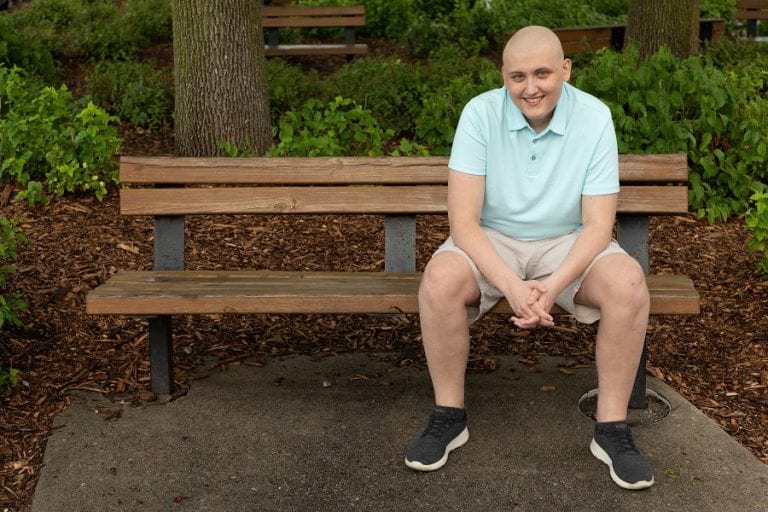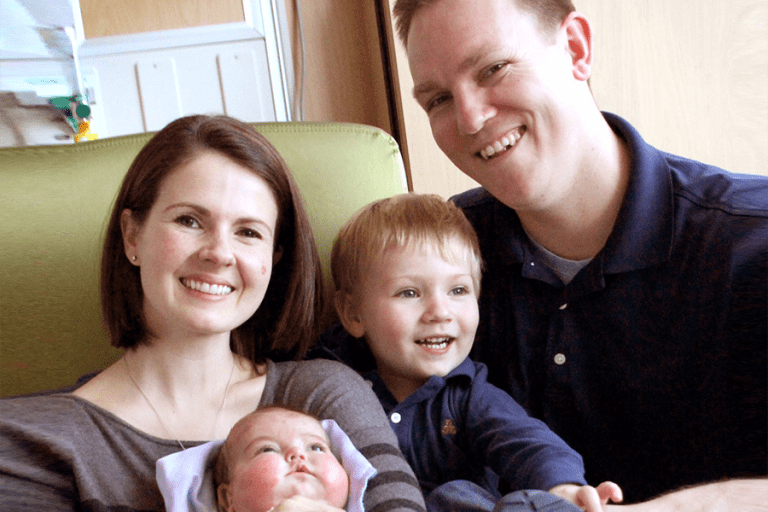To his family, 9-year-old Joseph is a treasure, with a great love for friends, his big sisters, and a budding acting career. Today you would never know he had gone through not one, but two, dangerous—yet lifesaving—bone marrow transplants to cure a rare genetic disease, myelodysplastic syndrome (MDS).
When Joseph was 2 ½ years old, his parents Brian and Mary noticed that Joseph tended to bruise easily. Pediatricians in their home state of Vermont advised them to have him tested for a common bleeding disorder prior to any surgical procedures. With that in mind, they had Joseph tested before a minor procedure to remove a venous malformation on his arm. His doctors were very concerned with the initial test results and ordered a bone marrow biopsy but, to his family’s relief, the test showed no leukemia.
Two weeks later, Mary received a phone call from their doctor. It’s been nearly seven years since that call, but she still remembers his exact words: “Mary, I don’t have anything good to tell you.” He proceeded to tell her that Joseph had MDS with monosomy 7, and the only hope for a cure was a bone marrow transplant. Without it, he would not live more than two years.
In disbelief, Mary turned to her previous experience working as a clinical trial coordinator at the Vermont Cancer Center. She knew that Joseph’s best chance depended on learning about new research, identifying the doctors who were leading the field, and locating where clinical trials using bone marrow transplants were taking place. So she did just that, devoting hours to researching online, looking at reputable research journals, and searching for doctors who authored the research articles.
Mary says that staying close to home, family and friends wasn’t a top priority, “We would go to wherever had the best care, and that was the University of Minnesota.” They set up a meeting with Dr. John Wagner to hear more about the University’s bone marrow transplant program and ultimately made the decision to come to Minnesota. Mary says that she was struck by Dr. Wagner’s personal passion to help kids with rare diseases and remembers him saying, “My mission is to find a cure for the incurable.”
The family picked up and moved their entire family halfway across the country and settled into life in Minnesota. Although it was a whirlwind, Mary recalls, “Amidst the chaos, we had one focus….to save Joseph’s life.” Gratefully, Brian was able to take an unpaid leave from work; Mary left her many volunteer roles; and Joseph’s older sisters, Allie and Katey, then ages 7 and 5, respectively, left their school and enrolled in school at the Ronald McDonald House.
The Krupski family stayed in Minneapolis from March-December 2006. Joseph spent many of those weeks in the hospital, with his mom and dad switching back and forth on 24-hour shifts. The family also had two Care Partners volunteers. Care Partners is a volunteer program funded by Children’s Cancer Research Fund, and Mary and Brian were very grateful for their support during this difficult time. “Care Partners sat with Joseph when we needed to take some time to make some of the biggest decisions in his care and when we needed to step out and see that life around us was still going on,” remembers Mary.
Not one, but two
Joseph had a single cord blood transplant on April 7, 2006, a few weeks before his 3rd birthday. Joseph struggled badly with graft-vs.-host disease (GVHD) in the months following transplant, and by five months post-transplant, they received the devastating news that his transplant had failed. His MDS had come back, and his bone marrow was failing. Mary remembers meeting with doctors in a conference room in the former University of Minnesota Fairview Hospital (now the University of Minnesota Masonic Children’s Hospital): “We knew it was bad news when you got called into that room. And now we were the parents in that room.”
During that meeting, the Krupskis learned that a second transplant was an option for Joseph, albeit a risky option so soon after his first. Mary remembers vividly the page in her notebook from that meeting, “I scribbled down, ‘Greater chance of success. Greater chance of death.’ And yet, that’s the choice we went with, knowing it was the only chance.”
For his second transplant, Joseph received a double umbilical cord blood (dUCB) transplant. Joseph was the first pediatric patient at the University of Minnesota—and likely the world— to receive the Minneapolis Regimen, a treatment developed by Dr. Wagner and his team. Prior to Joseph, the ‘Minneapolis Regimen’, as it has come to be known worldwide (referring to the conditioning treatment and dUCB transplant procedure) had only been used in adult patients since one unit was not a sufficient amount. However, at the time of Joseph’s transplant, Dr. Wagner and his colleague at the U of M, Dr. Michael Verneris, had recently discovered that the use of two UCB units was associated with a marked reduction in the risk of relapse. As a result, Joseph became a part of medical history.
Mary says, “We always had the feeling that the doctors at the U have seen it all…the side effects, the complications, and the miracles…we knew we were in the right place.”
Miraculously, Joseph recovered very well from his second transplant. He didn’t struggle with GVHD, as doctors had anticipated he would. The family was able to return home to Vermont in December 2006, after being gone more than 10 months. They returned to an amazing homecoming with a fire engine escort from the airport, Santa Claus, and a street lined with people celebrating Joseph’s recovery. For the family, it was a Christmas they won’t ever forget.
A Minnesota homecoming
Nearly two years after Joseph’s transplant, Brian received a job offer from Target. Mary says, “We were excited by the possibility of returning to Minnesota, which had been so good to us, with the added bonus of being close to Joseph’s doctors.” In the summer of 2008, the Krupskis packed up and moved back to Minnesota, this time permanently, and enrolled Joseph in kindergarten. Mary recalls, “It didn’t seem real…it was all really amazing. We love our new home state. Our children quickly became Wild and Twins fans and have made Minnesota their home.”
As for Joseph, today he is an energetic 9-year-old boy, who loves spending time with his friends. Mary wonders if he’s making up for lost time from his early years when he spent a lot of time isolated from his peers. This summer, he’s looking forward to playing soccer and acting in a local theater production of “Jack in the Beanstalk,” along with the family’s annual train trip back to the East Coast.
And the family has never forgotten the importance of giving back to those who supported them during their cancer journey. Among their many charitable activities, the family has made meals at Ronald McDonald House, and Mary speaks at American Red Cross meetings and participates in Children’s Cancer Research Fund’s Time to Fly event, among others.
The family is also a firm believer in research. “Research is the path to cures. I can’t imagine what we would have felt if someone had said there wasn’t a cure for Joseph. When you are told that your child has a rare disease, you want to know that there is a team of people working on finding a cure,” says Mary.



